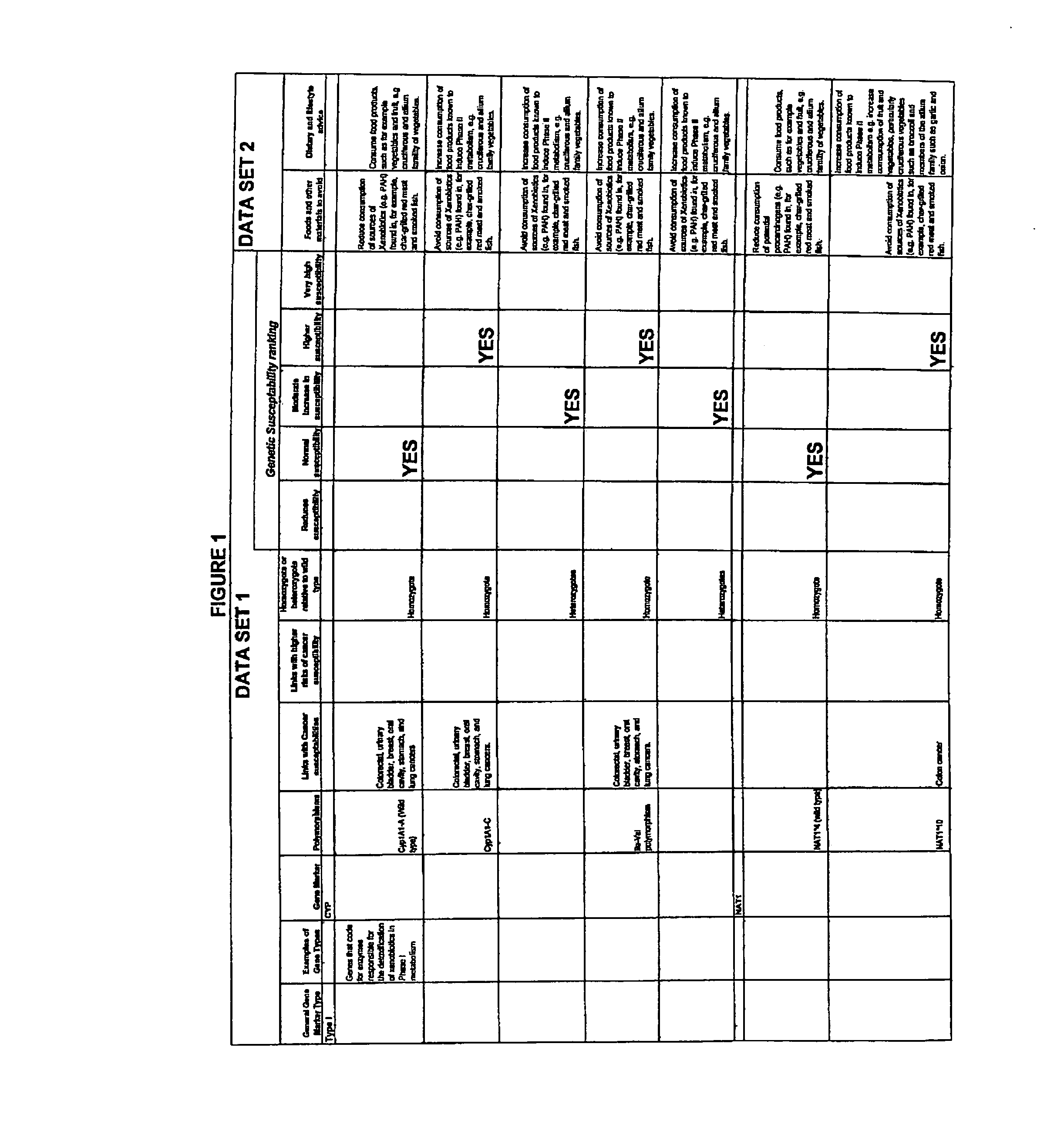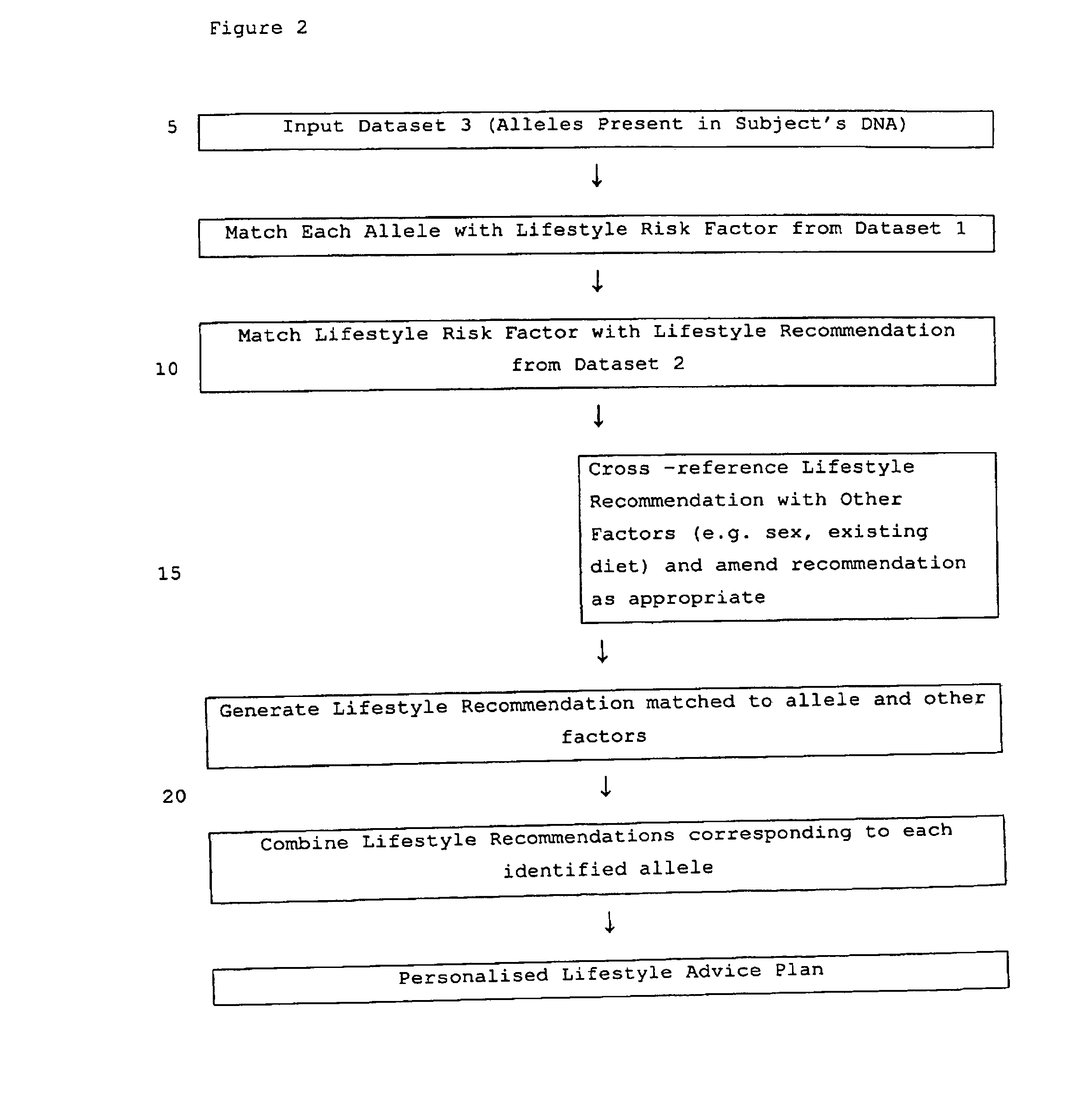Computer-assisted means for assessing lifestyle risk factors
a lifestyle risk factor and computer-aided technology, applied in the field of methods of assessing disease susceptibility, can solve the problems of loss of the regulatory mechanisms that govern normal cell behaviour, formation of tumours with full metastatic (or invasive) potential, increased or decreased carcinogen activation, etc., to protect and manage their own health, and reduce the risk of disease
- Summary
- Abstract
- Description
- Claims
- Application Information
AI Technical Summary
Benefits of technology
Problems solved by technology
Method used
Image
Examples
example 1
Preparation of DNA Sample
[0136]DNA is prepared from a buccal cell sample on a brush using a Qiagen QIAamp kit according to the manufacturer's instructions (Qiagen, Crawley, UK). Briefly, the brush is cut in half and one half stored at room temperature in a sealed tube in case retesting is required. The other half of the brush is placed in a microcentrifuge tube. 400 μl PBS is added and the brush allowed to rehydrate for 45 minutes at room temperature. Quiagen lysis buffer and Proteinase K is then added, the contents are mixed, and allowed to incubate at 56 C for 15 minutes to lyse the cells. Ethanol is added and the lysate transferred to a QIAamp spin column from which DNA is eluted after several washings.
example 2
Quantification of DNA
[0137]In order to check that sufficient DNA has been isolated, a quantification step is carried out using the PicoGreen dsDNA Quantification kit (Molecular Probes, Eugene, Oreg., USA).
[0138]Briefly, client DNA samples are prepared by transferring a 10 μl aliquot into a microcentrifuge tube with 90 μl TE. 100 μl of the working PicoGreen dsDNA quantification reagent is added, mixed well, and transferred into a black 96 well plate with flat well bottoms. The plate is then incubated for 5 minutes in the dark before a fluorescent reading is taken. The quantity of DNA present in the clients' samples is determined by extrapolating from a calibration plot prepared using DNA standards.
[0139]A quantity of DNA in the range of 5–50 ng total is used in the subsequent PCR step. Remaining client DNA sample is stored at −20° C. for retesting if required.
example 3
Taqman® Assay to Identify the MTHFR A1298C Polymorphism
[0140]The modified reaction mixture contains Taq polymerase (1.25 units / μl), optimised PCR buffer, dNTP (200 μM each), 2 mM MgCl2 and primer pairs SEQ ID NO: 160 and 161 and polymorphism probe SEQ ID NO: 200.
[0141]The reaction mixture is initially incubated for 10 minutes at 50° C., then 5 minutes at 95° C., followed by 40 cycles of 1 minute of annealing at between 55° C. and 60° C. and 30 seconds of denaturation at 95° C. Both during the cycles and at the end of the run, fluorescence of the released reporter molecules of the probe is measured by an integral CCD detection system of the AB7700 thermocycler. The presence of a fluorescent signal which increases in magnitude through the course of the run indicates a positive result.
[0142]The assay is then repeated with the same primer pair and wt probe SEQ ID NO: 199. If the sample is homozygous for the polymorphism, no fluorescence signal is seen with the wt probe. However, if the ...
PUM
| Property | Measurement | Unit |
|---|---|---|
| chemical carcinogens | aaaaa | aaaaa |
| enzyme activity | aaaaa | aaaaa |
| lipophilic | aaaaa | aaaaa |
Abstract
Description
Claims
Application Information
 Login to View More
Login to View More - R&D
- Intellectual Property
- Life Sciences
- Materials
- Tech Scout
- Unparalleled Data Quality
- Higher Quality Content
- 60% Fewer Hallucinations
Browse by: Latest US Patents, China's latest patents, Technical Efficacy Thesaurus, Application Domain, Technology Topic, Popular Technical Reports.
© 2025 PatSnap. All rights reserved.Legal|Privacy policy|Modern Slavery Act Transparency Statement|Sitemap|About US| Contact US: help@patsnap.com


